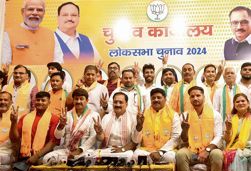
iStock
Vijay C Roy in Chandigarh
HOW badly are you off for money? If the honest answer is pretty bad, you may consider the P2P route – the ‘Peer to Peer’ lending platform. The Reserve Bank of India recently issued guidelines about P2P business. So, your options could be more than 30 players, some of which are Faircent, LendBox, LenDenClub, IndiaMoneyMart, Monexo, Rupaiya Exchange, LoanBaba, CapZest and i2iFunding. There is no available data, however, according to the industry, around 3-4 lakh users are registered with various P2P platforms.
Here are the pros and cons: There are no foreclosure charges (pre-payment penalty charges). The interest rate is higher than the public and private sector banks’. Nil foreclosure charges would mean you may pay less by paying earlier than the stipulated period.
How it works
P2P lending is a new-age finance offered by the people, for the people. The P2P platforms act as financial matchmakers between the lenders and borrowers by providing them an online marketplace to connect with each other and negotiate a fair deal without any financial intermediaries.
Online P2P lending is the simple act of an individual using one’s surplus funds to provide credit to a business or another individual through digital platforms. The sector has been facilitating easier access to lending products for consumers who are either denied credit by traditional banks or are entirely unserved.
The mechanism involves deploying state-of-the-art technologies and big data analytics to assess the creditworthiness of borrowers and make accessing and distributing credit easier and reliable. Technology also helps in reducing transactional costs.
Co-founder of i2iFunding, India’s second largest P2P platform Raghavendra Pratap Singh says only about 3-4% Indians manage to avail of unsecured loans from banks. “Only a little over 1% of India’s total population has any bargaining power on interest rates with banks. The borrowers are stuck to this route because of lack of alternatives. Conventional NBFCs (non-banking financial companies) which primarily depend on banks for funding lend at a higher rate. Else, they ask for collaterals. The MFIs (micro-finance institutions) and private lenders charge exorbitant rates. P2P lending platforms are likely to provide both transparency and availability.”
P2P lending platforms offer other advantages such as, they charge borrowers no prepayment penalty, they don’t have hidden costs and have more flexible offerings in the unsecured credit space. “This option facilitates swift and seamless access to financial services, enables strategic investments of flexible sizes, and adds value to lenders and borrowers at both ends of the transaction. The automated processes and intelligent systems to generate credit scores also reduce the risks. Returns are generated from the very next month in the form of loan interest, which allows lenders to maximize their capital through compounded returns,” says Rajat Gandhi, founder & CEO, Faircent.com.
NBFCs & P2P
P2P lenders have been accorded the status of NBFCs for regulatory purposes. But the two are different entities: while NBFCs invest their own funds or someone else’s funds on their behalf, P2P lending platforms are facilitating individuals seeking or looking to provide credit into the market.
Also, P2P lending takes a different approach. It allows people to provide credit to borrowers, regardless of the end-function. While they might functionally result in the same outcome -- the disbursal of credit — the methods and framework are very different.
Sarvjeet Singh Virk, co-founder & MD, Finvasia says P2P will complement not only the banking industry but financial market also. Being technology-driven, it will make its own space in the market in due course of time. Efficiencies on account of increasing competition will make interest rates more market-driven and will definitely put pressure on the ways banks and NBFCs operate. Ultimately, it is customer who will gain the maximum, said Virk.



























